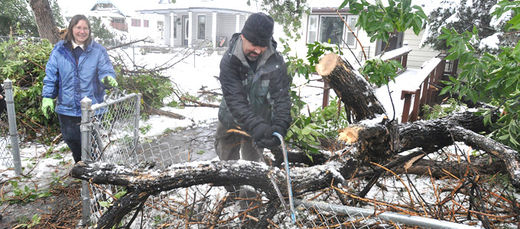OF THE
TIMES
In addition to robust multi-decadal warming, global mean surface temperature exhibits substantial decadal and interannual variability (see Figure SPM.1). Due to natural variability, trends based on short records are very sensitive to the beginning and end dates and do not in general reflect long-term climate trends. As one example, the rate of warming over the past 15 years (1998 - 2012; 0.05 [ - 0.05 to +0.15] °C per decade), which begins with a strong El Niño, is smaller than the rate calculated since 1951 (1951 - 2012; 0.12 [0.08 to 0.14] °C per decade).And from page 12:
The observed reduction in surface warming trend over the period 1998 - 2012 as compared to the period 1951 - 2012, is due in roughly equal measure to a reduced trend in radiative forcing and a cooling contribution from internal variability, which includes a possible redistribution of heat within the ocean (medium confidence). The reduced trend in radiative forcing is primarily due to volcanic eruptions and the timing of the downward phase of the 11-year solar cycle. However, there is low confidence in quantifying the role of changes in radiative forcing in causing the reduced warming trend. There is medium confidence that internal decadal variability causes to a substantial degree the difference between observations and the simulations; the latter are not expected to reproduce the timing of internal variability. There may also be a contribution from forcing inadequacies and, in some models, an overestimate of the response to increasing greenhouse gas and other anthropogenic forcing (dominated by the effects of aerosols). {9.4, Box 9.2, 10.3, Box 10.2, 11.3}Regarding the cause of the warming, still living in fantasy world, they write:
Greenhouse gases contributed a global mean surface warming likely to be in the range of 0.5°C to 1.3°C over the period 1951−2010, with the contributions from other anthropogenic forcings, including the cooling effect of aerosols, likely to be in the range of −0.6°C to 0.1°C. The contribution from natural forcings is likely to be in the range of −0.1°C to 0.1°C, and from internal variability is likely to be in the range of −0.1°C to 0.1°C. Together these assessed contributions are consistent with the observed warming of approximately 0.6°C to 0.7°C over this period. {10.3}They're still misleading the public. Everyone knows (well, many of us know) their models can't simulate the natural processes that cause surface temperatures to warm over multidecadal timeframes, yet they insist on continuing this myth.

'In the beginning there was no fire, and the world was cold, until the Thunders (Ani´-Hyûñ´tikwalâ´ski), who lived up in Galûn´lati, sent their lightning and put fire into the bottom of a hollow sycamore tree which grew on an island. ... This was a long time ago. ... still there was no fire, and the world was cold ...'Eventually, mythical beings succeeded in acquiring the fire. At tropical latitudes meanwhile, the Quiché Maya (Guatemala) related that their first ancestors were overcome by circumstances most peculiar for central America:
'After that a great downpour began, which cut short the fire of the tribes. And hail fell thickly on all the tribes, and their fires were put out by the hail. Their fires didn't start up again. ... And so again the tribes arrived, again done in by the cold. Thick were the white hail, the blackening storm, and the white crystals. The cold was incalculable. They were simply overwhelmed. Because of the cold all the tribes were going along doubled over, groping along ...'And the Bibbulmun nation (southwestern tip of Australia) referred to the 'Dreamtime' or the 'ancestral' time (Demma Goomber) as the 'Nyitting times, the cold, cold times of long ago'. As the name says, the Bibbulmun qualified this past era as one dominated by unprecedented cold - and, consequently, by a savage mode of living:
Comment: From 'Hiding the Decline' to 'Burying the Pause': Man-made Global Warming is still a lie